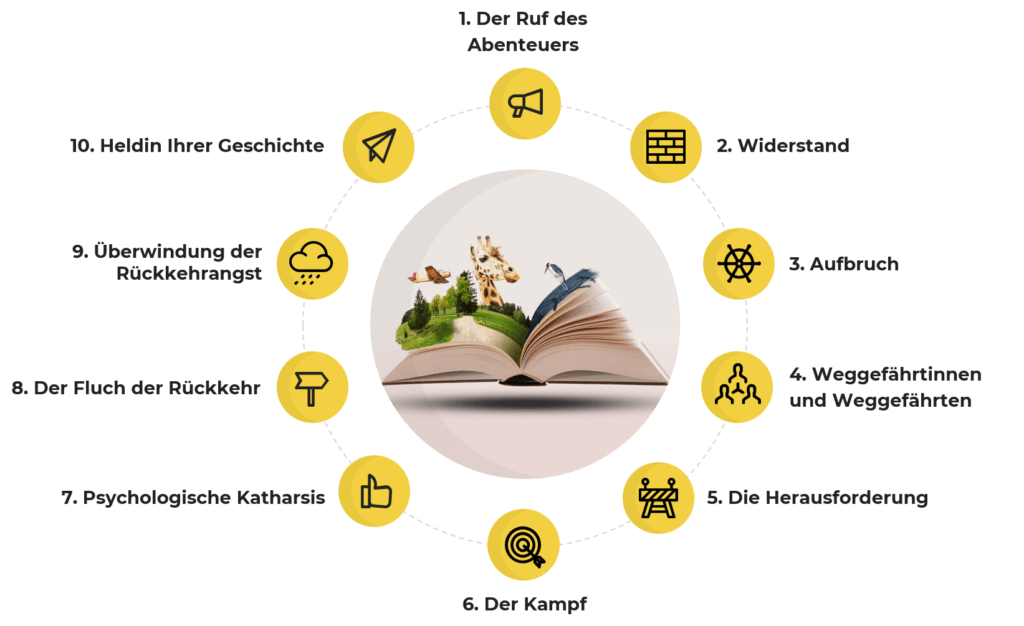I can still clearly remember a coaching session in which I myself was the client and went through a storytelling tool. The title of my fairy tale was “Kinga, trapped in the pit of doubt”. I didn’t know at the time that by my choice of title I had unconsciously chosen a classic element from the archetypal heroine myth: The Night Sea Voyage. Here the term is not to be understood literally, i.e. it is not necessarily about a journey on the sea at night, but rather about a descent into the depths of the subconscious.
About the magic of storytelling
It is this process that elevates storytelling to a skill with depth and gives the lie to those who claim that it is merely a marketing tool that serves their own self-dramatization.
With every story we share with others, we not only reveal a piece of ourselves, we also get to know our inner world better, re-evaluate experiences, and through this we can also invite others to a change of perspective.
That we are moved by similar narrative patterns was already shown by the founder of analytical psychology Carl Gustav Jung, who called the recurring narrative structures “archetypes of the hero myth/heroine myth”.
Structure and symbols in storytelling
In storytelling, these patterns are found not only in the narrative structure, but also in the symbols used. Here we encounter not only creepy creatures of the deep or magical beings of light. We also subconsciously use universal symbols, such as circles, crosses or other geometric shapes, with the help of which we gradually try to structure the collective subconscious.
Specifically, this means that we use familiar “primal symbols” for support to solve human problems. These can be, for example, unresolved life issues such as a separation, the loss of a job, the death of a relative, but also marriage, starting a family or a long-awaited move.
So the recurring telling of our story helps us to renegotiate fundamental issues in life, whether these are the life issues mentioned above, “simple” conflict situations, or unconscious issues (e.g., negative beliefs).
The mythological narratives (mythical beings, magic objects, but also unexpected heroes/heroines) here form both inner parts of our selves (keyword: inner team), as well as the imaginary personification of real existing people. So the monster can stand for the choleric boss or the heroine on the white steed, for the friendly neighbor next door.
Through correction to reorientation and reassessment
For this reason, the fairy tale tool mentioned at the beginning is a valuable support not only in the context of coaching, in order to reorient oneself personally, professionally or entrepreneurially. The narrative-analytical coaching method also helps to re-evaluate one’s own story, to develop multiple perspectives and to “experience” one’s own heroine’s journey in a completely new way.
But how does good storytelling actually work? In my article “5 rules for great storytelling: are you just selling or are you already telling?” I already shared with you the essential tips of solid storytelling.
Today I would like to go one step further and give you a little insight into the structural design.
Basically, we can say that storytelling is always about the same basic structure:
- The protagonist is confronted with a seemingly unsolvable problem/conflict.
- The heroine must overcome challenges to solve the problem.
- In the end, the heroine successfully returns and has found a solution.
Between these main building blocks the adventure takes place, which leads us into the depths of our fears (keyword: night sea voyage). However, by overcoming a powerful opponent, we ultimately manage to recognize, activate and strengthen the inner, hidden parts within ourselves. In the process, we use or encounter the symbols mentioned above, meet companions along the way, and learn to rewrite our heroine’s journey.
Welcome to your personal heroine journey

But how can I “demystify” storytelling a bit and thereby discover it for my own entrepreneurial or professional path?
I would like to share this with you and, following the mythologist Joseph Campbell, show you how to find your own heroine story in 10 steps:
1. the call of adventure
Each of us has experienced small and large conflicts in life. Whether at work, at university, as an entrepreneur or in private life: We make hundreds of decisions almost every day, and not every one of them is made without conflict. In the case of major general human decisions within the framework of the so-called “tractor goals” (partnership, marriage, family planning, place of living, career, personal development, etc.) as well as in the case of age-, gender- or culturally-related conflicts, the call of adventure is usually particularly loud. So the first step of your narrative always begins with reflection: what moment led to an existential change? If you find at this point that you are in danger of getting lost in the fullness of your comprehensive story, take a subplot. As with movies, the side stories are mostly just as exciting and deserve to be told as well.
2. resistance
Even if social media often suggests otherwise, in most (real) situations, the protagonist does not immediately jump into the adventure when the call for it sounds. The best way to see this is in entrepreneurship. Of course, there are those who “just jump” and then see if they survive. However, this is true for very few founders. As a rule, planning your own independence often involves self-doubt, pulling out your hair and a long walk into the depths of your own subconscious to see which inner team member is actually influencing you negatively. I had described this passage at the beginning also with me (you still remember? “Kinga, caught in the pit of doubts”?).
3. departure
With professional support, for example within the framework of a coaching program specially developed for this purpose, the above-mentioned thoughts can be very easily overcome, let go of and above all: also unmasked quite quickly in the future, so that learned action strategies can also be applied here in the future. So, to avoid forever falling into the “pit of despair,” you should definitely invest in professional support as part of the storytelling process, because I promise you, in entrepreneurship, you always have one foot hovering over said pit.
4. companions along the way
Even if we often fear that we are alone with our problem, on closer inspection we find many resources outside and inside as well as courageous and inspiring sparring partners who accompany us on our way. At this point I can also tell you that they also threw a “rope” into my pit. Although I was hesitant, in the end this was the chance for me to escape my self-doubt. Unless you are considering professional support (see point 3) for yourself, consider who else can accompany you on your journey. Does your partner or a friend share your professional/entrepreneurial interests? Is there a mentoring program in the company where you are employed? Are there designers, tax consultants, etc. in your area with whom a collaboration or cooperation would be conceivable? Always keep the following in mind: A cooperation always takes place at eye level, i.e. your offer must always contain an absolute added value for the other person, because they are giving you the most important thing they have: Time and know-how. In the context of a workshop, coaching or mentoring, a collaboration is always a financial investment, which you can also deduct from your taxes if you use it in connection with professional or entrepreneurial topics.
5. the challenge
The call has been made, we have successfully overcome our inner resistance and found our first supporters. Now the first test takes place, because the number of conflicts is increasing. Challenges here can be a flood of new projects, a lack of liquidity, an internal conflict or even supposedly smaller but very important internal conflict situations, such as a lack of motivation, pressure and excessive demands. The protagonist now begins the first unconscious behavioral and personality corrections. In my case, for example, it was the realization that I can’t run a business with an employee mindset. I had to completely restructure myself, make Design Thinking my daily companion and got to know “(self-)discipline” on a whole new level.
6. the fight
From the minor challenge and confrontation with new issues, the real attack on our inner (and outer) manipulator now begins. This can be a real person, such as the manager, who has no regard for your personal needs. Or the family, which denies you the entrepreneurial competence as well as the society, which tries to suppress you with your immeasurable expectations. You are already on the battlefield, but the decision has not yet been made whether you want to fight this battle. You weigh things up, have conversations, get (professional) support (keyword: companions) at your side and ultimately decide that this battle is worth fighting. You don’t want your heroine journey to end without a fight.
7. psychological catharsis
You have made it and gone one step further: You have doubted, struggled, maybe even screamed or cried, but you have gone the distance and leave the pitch a winner. The victory over doubters, critics and so-called “energy vampires” has had an incredible side effect: you can now unmask, refute or completely let go of old patterns of experience, beliefs and supposed character weaknesses. They have gone through a kind of “inner cleansing process”. This is not to say that you will not find the heroine’s journey equally challenging when you call for adventure again, but you will learn new things from each adventure, meet new companions, and readjust, reevaluate, and reorder your inner parts.
8. the curse of return
Every heroine takes away from an adventure not only positive. Sometimes we get disappointed, we “fail” at other things, even if we have won the supposed main victory. We lose power for a short time. In entrepreneurship, one perceives this step very clearly. For example, there are start-ups that have been successful, but trusted team members and friends have left the common path (e.g. Apple). In this case, the return is complicated by the loss and also needs a certain mourning process in order to process it. In the private sphere, we feel this phase, for example, when a successfully completed study and a great job (struggle and victory) are followed by the loss of existing contacts, because the new job is associated with a move.
9. overcoming the fear of return
Fortunately, every adventure, even the one in which we supposedly failed, always ends well. Of course, there are adventures that hold a longer period of misfortune and challenge (e.g., illness or death), but in perspective, we always end up deciding for ourselves how to evaluate our heroine’s journey. The return, however, holds another (unintended) consequence here, because often the heroine’s journey is not only seen as a factor of identification, but is questioned. Thus, it is quite possible that after returning, the protagonist skips the last step (see point 10) and immediately finds herself in a new reputation. This can be the case, for example, when a woman has built a successful career against all (well-intentioned) advice and is subsequently confronted with the full force of social norms (child, house, marriage, etc.).
10. heroine of your story
The previously mentioned danger of going from one adventure to the next cannot be avoided entirely, because we never run out of conflicts. If they do not meet us on the outside, we at least find them in large numbers on the inside. The positive news, however, is that we are no longer the naive heroine from the beginning. We have learned, reflected, communicated, fought, cried, and resisted, and while each new call means a new descent into the depths of our subconscious and all the fears that go with it, we face them with an entirely new attitude. We replace the naïve with the brave, the brave with the rebellious, and the rebellious with the domineering, and so on. While all these inner parts influence our intuitive knowledge and thereby the archetypal pattern of our soul, they equally cause a never-ending correction of our consciousness.
Conclusion
So in the end, you can say:
No matter with which attitude our heroine journey ends, the following one forms a new point on the steady path of our personal development. So when a client tells me, “There’s not that much to tell about me,” all that’s left for me to ask is, “So is your life adventure over already?”
I hope this article was able to give you an initial guide on how storytelling can work. If you read carefully, you could also learn a piece of my own story or professional background from each step, because that is also part of the art of storytelling: to tell without telling.
The only question left unanswered now is, “What call for adventure reached you today?”




